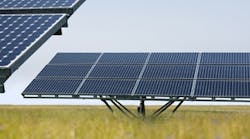The problem has become increasingly apparent as we try to increase the percentage of wind and solar versus fossil-fueled generation, said Alan Langworthy, global business renewable energy integration manager, ABB, in his presentation, "Microgrids and Renewable Integration," this week at ABB Automation and Power World 2012 in Houston, Texas. "It's like the Goldilocks fairy tale," he says. "We don't want so little renewable power that we can't get a good return on our capital investment or so much that it causes a trip. We want just the right amount so we can make the best investment and get maximum returns."
The problem is the variable output of wind and solar PV, and not just because sometimes the wind doesn't blow and there's no sun at night. "A windmill can go from 100% to 20% output and back in three seconds," Langworthy says. "On a cloudy day, a PV array can go from 30% as a cloud passes over it to 130% as it catches full sun plus a reflection from the underside of another cloud. These rapid variations wreak havoc on grid-protection systems."
Battery-energy storage systems are not well-suited to absorbing and discharging energy to stabilize these oscillations. Existing batteries are able to discharge fast enough, but absorb a charge more slowly, and this asymmetrical behavior makes it difficult to use them effectively. Plus it's really hard on them, Langworthy says, "It's essentially putting an AC current on the battery."
Langworthy's group solves the problem using flywheel-based energy storage units that introduce "synthetic inertia," and are able to absorb peaks and fill sags with a reaction time of five milliseconds, an order of magnitude faster than they occur. The inverter and flywheel units correct both real and reactive power fluctuations, controlling voltage and frequency to stabilize the grid and keep renewable units online and producing usable power.
The PowerStore flywheel/inverter units can be combined with ABB communications and control systems to fully integrate renewables. With full integration, the "Goldilocks" sweet spot can be expanded enormously, in some cases up to 100%. Langworthy described, among other examples, a diesel generator and solar microgrid for the town of Marble Bar in Australia. On sunny days, a 300-kW solar array with a 500-kW PowerStore unit can power the town with no diesel generators running—and no batteries.
Goldilocks would find that to be "just right."




